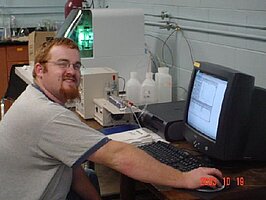A Study of Microbial Re-growth Potential of Water in Fargo, North Dakota and Moorhead, Minnesota

Trent Museus is a M.S.(Environmental Engineering) student at North Dakota State University (NDSU) Fargo, North Dakota. Trent was born in Brainerd, Minnesota and graduated with honors from Brainerd High School in 1999. While attending high school, he also attended classes at Central Lakes College (CLC) in Brainerd, Minnesota using the Post Secondary Enrollment Option. He obtained college credits while simultaneously attending high school. He then transferred his earned credits from CLC to NDSU. Trent graduated from NDSU in May 2003 with a double major in Civil Engineering and in Construction Engineering.
Fellow: Trent Museus, Department of Civil Engineering, NDSU
Advisor: Eakalak Khan, Assistant Professor of Civil Engineering, NDSU
Matching Support: NDSU
Degree Progress:M.S. expected in May 2005.
A Study of Microbial Re-growth Potential of Water in Fargo, North Dakota and Moorhead, Minnesota
Biodegradable dissolved organic carbon (BDOC) and assimilable organic carbon (AOC) have been used to examine the re-growth potential of water throughout the world. Furthermore, AOC is included in the latest Standard Methods (1998). However, the regrowth potential of water in Fargo, North Dakota and Moorhead, Minnesota has never been evaluated; BDOC and AOC values of water in Fargo and Moorhead have not been reported. The ultimate goal is to minimize the concentrations of these two parameters in treated water provided by the Fargo and Moorhead water treatment plants which in turn will benefit public health by limiting the number of microorganisms in tap water. Collecting BDOC and AOC data is a first step to achieve the ultimate goal. The data will also indicate the degree of susceptibility of drinking water of Fargo and Moorhead to microbial proliferation.
It is crucial that BDOC and AOC of water in Fargo and Moorhead are studied because of the nature of high total organic concentrations in the influent and effluent and the use of ozonation at both treatment plants. BDOC and AOC tend to be high with these two conditions. The influent (from the Red River for the Fargo plant and the Red River blended with groundwater at 85%:15% for the Moorhead plant) and effluent total organic carbon (TOC) concentrations at both plants are sometimes as high as 8 to 10 mg/L and 1 to 2 mg/L, respectively. BDOC is a portion of total organic concentrations. Although water with high total organic concentrations does not necessarily contain large amounts of BDOC, positive linear relationships have been frequently observed between the two parameters (Servais et al., 1987 and Khan et al. 1998b). As stated previously, ozonation of water with organics results in BDOC and AOC increases and their removal relies on the performance of subsequent treatment which normally is filtration. Currently, BDOC and AOC removal abilities of the filtration units at the Fargo and Moorhead plants are not known because the two parameters have not been measured.
Trent researching the evolution of assimilable organic carbon, biodegradable dissolved organic carbon and ultraviolet adsorbance at 254 nm (UV254)for the water treatment plants of the cities of Fargo and Moorhead and the distribution systems associated with each plant.
Scope of Work:
The main scope of this study is to collect BDOC and AOC data of water in Fargo and Moorhead in order to achieve the following objectives:
- To evaluate the microbial regrowth potential of water especially in finished water and tap water,
- To predict the regrowth occurrence in the distribution systems by comparing AOC and BDOC in finished water and those in tap water, and
- To compare BDOC and AOC removal of the Fargo and Moorhead plants which are different mainly in the presence and absence of the rapid mixing-sedimentation process.
Progress To Date:
Literature reviews have been performed to learn background information about the topic. The background information that has been reviewed assisted in the experiment design and processes that need to be followed. Preliminary testing has been performed. The preliminary AOC data are not reported due to problems encountered in the test method. The test method for AOC is very meticulous and leaves a lot or room for error and contamination. The problems that occurred have been corrected. The sampling and testing will continue until October 31, 2004. Also, practice testing consumed more time than was originally planned for.

Eakalak Khan
Civil & Environmental Engineering
NDSU


